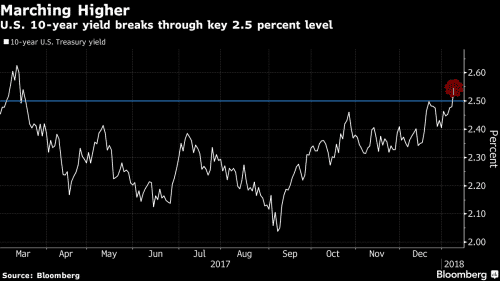Gundlach vs Gross: Here’s how a bond bear market starts
As a former bond guy, something Marc Chandler wrote a couple of days ago caught my eye.
“For the past two years, the central banks have bought all the new government bonds issued by the G10. This year, they will buy around 40%. The private sector will make up the financing gap.”
I think this change in monetary stance that Marc points out is the big worry these days in global bond markets. Long-term interest rates have backed up on the back of these worries, with the 10-year US government bond now trading above 2.50% for the first time since March. And this wasn’t just expected rate hikes filtering through the length of the curve; it was a steepening — the spread between two and 10 year yields steepened by six basis points yesterday, the most since November 2016.
So, there is a lot of angst as 2018 starts about where bond markets are headed given the tightening of monetary policy. Recent comments by Bond King Bill Gross — through the Twitter account of his firm Janus Henderson – only heighten the sense of agitation.
Gross: Bond bear market confirmed today. 25 year long-term trendlines broken in 5yr and 10yr maturity Treasuries.
— Janus Henderson U.S. (@JHIAdvisorsUS)
Adding to the market’s woes, Bond King heir apparent Jeff Gundlach agreed in principle with Gross that a bond bear market is definitely possible! The big caveat here is that Gundlach thinks yields have to rise further still before the trend line is broken, signalling the likely beginning of a bear market.
Gundlach says getting above 2.63% on the 10-year would be a “big deal,” likely pushing the 10-year towards 3%.
“If you get above 3%, then it’s truly, truly game over for the ancient bond rally.” pic.twitter.com/o5UiiAAs3K
— Myles Udland (@MylesUdland)
The big takeaway: It’s semantics whether 2.50%, 2.63% or 3.00% is the right level to declare a bear market in bonds. What matters is that the two best-known bond market investors are now saying we are in or near a bond bear market.
My take: one has to take these calls for the bond bull market’s end with a heavy dose of scepticism. If you look at bond rates as a combination of an expected real return, expected inflation and a term premium for the risk of holding a fixed return asset, only expected inflation can durably increase to cause an extended bear market. The term premium and the real return are not going to increase enough to create a long-lasting down cycle for bonds.
At the same time, if you look at what James Galbraith is saying about inflation, there has been no inflationary pressure from labor markets for 40 years. Not only do we see downward pressure on wages from global wage arbitrage as China, the Eastern Bloc, and India have entered the global trading system, we also have a more connected world generally due to globalization. And the Fed is still acting preemptively when unemployment hits relatively low levels, kneecapping wage growth.
All of this says any breakout in yield to the upside could be followed by a dramatic reversal to the downside as recession and private debt deleveraging come to the fore.

Comments are closed.